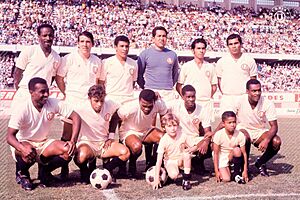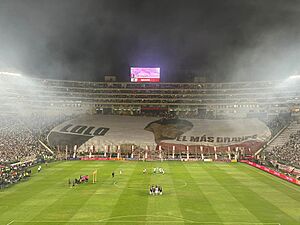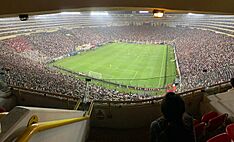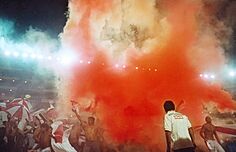Club Universitario de Deportes facts for kids
Club Universitario de Deportes is a famous Peruvian sports club from Lima. Its main sport is soccer, but it also has teams for women's football, volleyball, and basketball. The soccer team, often called Universitario or La U, has played in Peru's top league, the Liga 1, since 1928.
Universitario is the most successful soccer team in Peru, with 28 league titles. They have also never been relegated from the top division. The club started in August 1924 as Federación Universitaria. It was founded by students from the National University of San Marcos. In 1931, the club changed its name to Club Universitario de Deportes.
The team won its first Peruvian championship in 1929, just one year after joining the first division. They won titles in two years in a row in 1945 and 1946. In 2000, they achieved a "treble" by winning three championships in a row. Universitario was also the first Peruvian club to reach the final of the Copa Libertadores in 1972.
Universitario is one of the two most popular teams in Peru. Their youth team, U América FC, plays in the Copa Perú. According to the International Federation of Football History and Statistics (IFFHS), Universitario was the best Peruvian club of the 20th century. They were also ranked as the 28th most successful club in South America during that time.
In 2000, Universitario opened the Estadio Monumental, which can hold 80,093 fans. It is the largest stadium in Peru and the second-largest in South America. Their older stadium, Estadio Teodoro Lolo Fernández, is now used for training and by the reserve team.
Universitario has a big rivalry with Alianza Lima, known as the Peruvian Clásico. This rivalry started in 1928 and is one of the most intense in South America. They also have rivalries with Sporting Cristal, Deportivo Municipal, and Sport Boys. The club has excellent sports facilities, including Estadio Monumental, Lolo Fernández, and Campo Mar, used for various sports.
Contents
Club History
Early Days and Foundation (1924–1927)
The club began on August 7, 1924. It was first called Federación Universitaria. Students and professors from the National University of San Marcos founded it. Key founders included José Rubio, the first president, and Dr. Luis Málaga, who designed the club's badge.
At first, Federación Universitaria was a small league. It organized tournaments between different university departments. The National Sports Committee of Peru recognized it as an official league. It then joined the Peruvian Football Federation. The club played friendly matches but did not join the Peruvian Primera División until 1928.
The Amateur Era (1928–1950)
In 1928, the Peruvian Football Federation allowed Universitario to join the top division. The team surprised everyone by finishing as runners-up in their first season. On September 23, 1928, Universitario played its first clásico against Alianza Lima. Universitario won that historic match 1–0.
The next year, in 1929, Universitario won its first league title. This stopped Alianza Lima from winning their third title in a row.
In 1931, the university asked the club to change its name. So, Federación Universitaria became Club Universitario de Deportes. They kept the famous "U" in their name. That same year, 18-year-old Teodoro Fernández, known as "Lolo" Fernández, joined the team. He became a legendary player.
Universitario's second title in 1934 caused some debate. The rules for that season were complicated. Universitario won a play-off match against Alianza Lima 2–1. The Peruvian Football Federation and FIFA both recognize Universitario as the champion of 1934.
In the 1941 season, Universitario won the title after beating Atlético Chalaco and Alianza Lima. They won back-to-back titles in 1945 and 1946. This was their first "bicampeonato" (two championships in a row). This success was thanks to star players like Víctor Espinoza, Teodoro Fernández, and his brother Eduardo Fernández. In 1949, the club celebrated its 25th anniversary by winning another championship.
The amateur era ended in 1950. Universitario had won seven league titles by then.
The Professional Era (1951–Present)
Professional football started in Peru in 1951. Universitario won its first professional game 4–1 against Mariscal Sucre FBC. On July 20, 1952, the Teodoro Lolo Fernandez stadium opened. Universitario beat Universidad de Chile 4–2 in the opening match. "Lolo" Fernández scored three goals.
Universitario won its eighth league title in 1959. In the 1960s, the club had even more success, winning five more championships. They won their second "bicampeonato" in 1960. As the 1960 champions, Universitario was the first Peruvian club to play in the Copa Libertadores, South America's biggest club competition.
In 1966, Universitario became the first national champion of the new Torneo Descentralizado. They won again in 1967, achieving their third "bicampeonato". In 1968, Universitario had its biggest Copa Libertadores win, beating Always Ready of Bolivia 6–0. They ended the decade with another national title in 1969.
1972 Copa Libertadores Final

In 1971, Universitario won its 14th league title. This qualified them for the 1972 Copa Libertadores. They were in a group with two Chilean teams. Universitario won their first game against Alianza Lima 2–1. They played well and advanced to the semi-final group stage.
In the semi-finals, Universitario faced strong Uruguayan teams, Peñarol and Nacional. Despite losing their first match, Universitario surprised everyone by beating Nacional 3–0. They then tied both away games in Montevideo. Universitario earned enough points to reach the final.
In the final, Universitario played against Independiente from Argentina. The first game in Lima was a 0–0 draw. In the second game in Argentina, Universitario lost 2–1, with Percy Rojas scoring their goal. Even though they lost, Universitario made history. They were the first Peruvian club to reach the Copa Libertadores final, a huge achievement for South American football.
In 1974, the club celebrated its 50th anniversary. They also won another championship under Argentine coach Juan Eduardo Hohberg.
Regional Tournaments (1980–1991)
The 1980s brought new tournament formats in Peruvian football. In 1982, Universitario won its 16th league title. They won the final group stage, called the Liguilla. A single goal by Hugo Gastulo secured the victory against Deportivo Municipal.
In 1985, José Luis Carranza became a key player for the club. Universitario won both the Torneo Regional and the Torneo Descentralizado that year, making them the 1985 champions. In 1987, Universitario won another title. They beat their rivals Alianza Lima in the final, breaking the tie for most Peruvian titles. In 1990, Universitario won the First Regional Tournament.
The Mid-Nineties (1992–1997)
In 1992, the league rules changed back to a simpler system. Universitario won the title a week before the final round. They beat CD San Agustín 4–1. With Sergio Markarián as coach, La U defended its title in 1993. They achieved another "bicampeonato" by beating San Agustín 3–0. This was the fourth time the club won back-to-back titles.
The Treble (1998–2000)
Universitario made history by winning three championships in a row from 1998 to 2000. This is called a "Tricampeonato" or treble. Oswaldo Piazza coached the 1998 winning team. Miguel Company and Roberto Challe led the club to the next two titles. Universitario was the third Peruvian team to achieve this. In 2000, they also won both the Apertura and Clausura tournaments in one season.
In the Copa Libertadores, Universitario reached the Round of 16 in 1998. However, they were eliminated in the group stage in 1999 and 2000. They also played in the Copa Merconorte four times but did not advance past the group stage.
2001–2009
After their treble, Universitario had less success for a while. In 2002, they won the Apertura play-off against Alianza Lima. In 2005, Universitario finished first in the overall table, qualifying for the 2006 Copa Libertadores. They advanced past the first phase but were eliminated in the group stage.
In 2008, Ricardo Gareca led Universitario to win the Apertura tournament. They secured the title with four games left, finishing 10 points ahead of Sporting Cristal. They beat Cienciano 3–1 to win the Apertura. In 2009, Juan Reynoso, a former player, became the new manager. Key players like Nolberto Solano joined the team.
In the 2009 season final, Universitario faced their arch-rivals Alianza Lima again. Universitario won both games. They won the first leg 1–0 with a goal from Piero Alva. In the second leg, Nolberto Solano scored the winning goal from a penalty kick.
By 2009, Universitario had 25 league titles. Seven were from the amateur era, and 18 from the professional era. They also won all four super clásicos that year.
2010–Present
In the 2010 Copa Libertadores, La U was in Group 4. They started with an away win against Blooming 2–1. They then beat Lanús 2–0 and tied 0–0 with Libertad. Universitario finished the group stage with 10 points and only two goals against. They were undefeated in the group stage. In the knockout stage, they faced São Paulo. Both matches ended 0–0, and São Paulo won on penalty kicks. Universitario left the Cup undefeated in regular play.
In the league, the team had a tough start in 2010 but recovered. Despite some challenges, they qualified for the Copa Sudamericana 2011. In the 2011 Peruvian Championship, Universitario improved and reached the quarterfinals of the Copa Sudamericana for the first time. They were eliminated by Vasco da Gama from Brazil.

Due to financial issues, the club underwent a restructuring process. In 2024, "la U" celebrated its 100th anniversary. They also won both the Apertura and Clausura tournaments in the season, claiming their 28th league title.
Colors and Badge
|
|
| Universitario's first kit |
|
|
| 2023 |
Universitario's main colors are cream (crema in Spanish), burgundy (granate in Spanish), and black. For home games, they wear a cream-colored kit with black socks. For away games, they use a burgundy-colored kit with black socks.
The club's first uniforms were white. One time, their white uniforms were being washed and turned yellow. This happened because the red color from the badges mixed with the white fabric. The team had to wear the yellow jerseys and won the game. Since then, they kept the cream/yellowish color as a good-luck charm.
The club's badge is a red "U" inside a deep-red circle. It was designed by Luis Malaga, one of the club's founders.
Stadium
Universitario's first stadium was Estadio Lolo Fernandez. It could hold 15,000 people. Now, its capacity is 4,000. It serves as a football academy for club members. It also hosts games for the reserve team and youth teams. The stadium was named after Teodoro "Lolo" Fernandez, a legendary Universitario player.
The Estadio Monumental was built in the 1990s and opened in 2000. It replaced Estadio Lolo Fernandez and the Nacional. Universitario won the first game played there, beating Sporting Cristal 2–0. Universitario now owns this stadium, which is the largest in Peru. It can seat 80,093 fans and is the second-largest stadium in South America.
For a few years, the stadium could not host the derby between Universitario and Alianza Lima. This was due to safety concerns after some fan violence in 2002. The derby returned to Estadio Monumental in 2008.
Supporters
Universitario has one of the largest fan bases in Peru. Only Alianza Lima has a similar number of supporters. Universitario's main fan groups are Barra Oriente and Trinchera Norte. Barra Oriente started in 1968 and has grown a lot. Trinchera Norte was formed in 1988.
Surveys often show Universitario and Alianza Lima as the two most popular teams. Their popularity numbers are usually very close. In some polls, Universitario is slightly more popular, while in others, Alianza Lima leads.
Players
Current Squad
|
|
Retired Numbers
- 9 –
 Teodoro "Lolo" Fernández, forward (1930–53) – Number retired since the 2013 season.
Teodoro "Lolo" Fernández, forward (1930–53) – Number retired since the 2013 season. - 22 –
 José Luis Carranza, midfielder (1986–04)
José Luis Carranza, midfielder (1986–04)
Players on Loan
|
Technical Staff
| Position | Name |
|---|---|
| Manager | |
| Assistant manager | |
| Assistant manager | |
| Physical trainer | |
| Technical advisor | |
| Goalkeeper manager |
Noted Managers

Many great managers have led Universitario to victory. Seventeen managers have won at least one major trophy. Arturo Fernández and Marcos Calderon each won a record four major titles. Roberto Scarone won three league titles and guided the team to the 1972 Copa Libertadores final.
Universitario's first manager, Mario de las Casas, won the club's first championship as a player-manager. Jack Greenwell, the only English manager in the club's history, won their second league title.
| Manager | Period | Trophies |
|---|---|---|
| 1928–29, 1934 | 2 Primera División | |
| 1939 | 1 Primera División | |
| 1941–49 | 4 Primera División | |
| 1959–62 | 2 Primera División | |
| 1964–67, 1985–86 | 4 Primera División | |
| 1969–74 | 3 Primera División | |
| 1974 | 1 Primera División | |
| 1987–90 | 1 Primera División | |
| 1990, 1994 | 1 Primera División | |
| 1991–93, 1997 | 1 Primera División | |
| 1993–94, 1995–96 | 1 Primera División | |
| 1997–98 | 1 Primera División | |
| 1999 | 1 Torneo Apertura | |
| 1999–01, 2015–17 | 2 Primera División | |
| 2002 | 1 Torneo Apertura | |
| 2007–08 | 1 Torneo Apertura | |
| 2009–10 | 1 Primera División | |
| 2013–14 | 1 Primera División | |
| 2023, 2025– | 1 Primera División | |
| 2024–25 | 1 Primera División |
Club Honours
Senior Titles
- Keys
- Record
- (s) Shared record
| Type | Competition | Titles | Runner-up | Winning years | Runner-up years |
|---|---|---|---|---|---|
| National (League) |
Primera División | 28 | 15 | 1929, 1934, 1939, 1941, 1945, 1946, 1949, 1959, 1960, 1964, 1966, 1967, 1969, 1971, 1974, 1982, 1985, 1987, 1990, 1992, 1993, 1998, 1999, 2000, 2009, 2013, 2023, 2024 | 1928, 1932, 1933, 1940, 1955, 1965, 1970, 1972, 1978,1984, 1988, 1995, 2002, 2008, 2020 |
| Half-year / Short Tournament (League) |
Torneo Apertura | 9 | 2 |
1998, 1999, 2000, 2002, 2008, 2016, 2020, 2024, 2025
|
1969, 2005 |
| Torneo Clausura | 3 | 6 | 2000, 2023, 2024 | 1997, 1999, 2006, 2007, 2016, 2019 | |
| Liguilla Pre-Libertadores | — | 2 | — |
1996, 1997
|
|
| Torneo Plácido Galindo | — | 1 | — |
1989
|
|
| Torneo Regional | 4 | 4 |
1985, 1987, 1988, 1990–II
|
1981, 1989–II, 1990–I, 1991–II | |
| Torneo Descentralizado | 1 | 1 |
1985
|
1988 | |
| Torneo Regional – Región Metropolitana | 6 | — |
1984, 1987, 1988 Grupo A, 1989–II, 1990–I, 1991–II
|
— | |
| Torneo de Primeros Equipos | 1 | 2 |
1934
|
1932, 1933 | |
| Campeonato de Apertura (ANA) | 3 | 4 |
1945, 1946, 1969
|
1947, 1955, 1956, 1961 | |
| National (Cups) |
Copa Presidente de la República | 1 | — |
1970
|
— |
| International (Cups) |
Copa Libertadores | — | 1 | — |
1972
|
Friendlies
| Type | Competition | Titles | Runner-up | Winning years | Runner-up years |
|---|---|---|---|---|---|
| National (Cup) |
Torneo Extraoficial | 1 | — |
1936
|
— |
| International (Cup) |
Copa El Gráfico-Perú | 1 | 4 | 2000 | 1999, 2001–I, 2001–II, 2005 |
Under-20 Team Honours
| Type | Competition | Titles | Runner-up | Winning years | Runner-up years |
|---|---|---|---|---|---|
| National (League) |
Torneo de Promoción y Reserva | 1 | 2 | 2024 | 2016, 2023 |
| Torneo Equipos de Reserva | 3 | 3 | 1930, 1931, 1932 | 1933, 1934, 1937 | |
| Half-year / Short tournament (League) |
Torneo del Inca | 2 | — | 2014, 2015 | — |
| International (Cups) |
U-20 Copa Libertadores | 1 | — | 2011 | — |
Performance in CONMEBOL Competitions
- Copa Libertadores: 35 appearances
- 1961, 1965, 1966, 1967, 1968, 1970, 1971, 1972, 1973, 1975, 1979, 1983, 1985, 1986, 1988, 1989, 1991, 1993, 1994, 1996, 1999, 2000, 2001, 2003, 2006, 2009, 2010, 2014, 2017, 2018, 2020, 2021, 2022, 2024, 2025
- Runner-up (1): 1972
- Copa Sudamericana: 8 appearances
-
- 2002: First Stage
- 2005: First Stage
- 2007: First Stage
- 2008: First Stage
- 2011: Quarterfinals
- 2015: Second Stage
- 2016: First Stage
- 2023: Knockout round play-offs
- Copa CONMEBOL: 2 appearances
-
- 1992: First round
- 1997: Semifinals
- Copa Merconorte: 4 appearances
-
- 1998: Group Stage
- 1999: Group Stage
- 2000: Group Stage
- 2001: Group Stage
- U-20 Copa Libertadores: 3 appearances
Other Sports
Women’s Football
| Type | Competition | Titles | Runner-up | Winning years | Runner-up years |
|---|---|---|---|---|---|
| National (League) |
Liga Femenina | 10 | 2 | 1996, 1997, 2001, 2002, 2003, 2014, 2015, 2016, 2019, 2023 | 2021, 2024 |
| Half-year / Short Tournament (League) |
Torneo Apertura | 1 | 1 |
2002
|
2025
|
| Torneo Clausura | — | 1 | — |
2002
|
|
| Regional (League) |
Región IV | 4 | — | 2014, 2015, 2016, 2019 | — |
| Zona Lima | 2 | — | 2015, 2019 | — |
- Copa Libertadores Femenina: 5 appearances
-
- 2015: Group Stage
- 2016: Group Stage
- 2017: Group Stage
- 2020: Group Stage
- 2023: Group Stage
Futsal
| Type | Competition | Titles | Runner-up | Winning years | Runner-up years |
|---|---|---|---|---|---|
| National (League) |
Primera División Futsal Pro | 3 | 3 | 2005, 2019, 2024 | 2006, 2022, 2023 |
- Copa Libertadores de Futsal: 2 appearances
-
- 2006: Quarterfinals
- 2021: 5th Place
Women's Volleyball
| Type | Competition | Titles | Runner-up | Winning years | Runner-up years |
|---|---|---|---|---|---|
| National (League) |
Liga Intermedia de Voleibol | 1 | — | 2024 | — |
Club Ranking
The International Federation of Football History and Statistics (IFFHS) ranks football clubs worldwide. As of May 31, 2023, Universitario de Deportes was ranked 201st globally.
- 198
 (216)
(216)  Galatasaray S.K. (84)
Galatasaray S.K. (84) - 199
 (208)
(208)  Brentford F.C. (84)
Brentford F.C. (84) - 201
 (237)
(237)  Universitario de Deportes (83)
Universitario de Deportes (83) - 202
 (207)
(207)  Philadelphia Union (82,5)
Philadelphia Union (82,5) - 203
 (249)
(249)  América de Cali (82,5)
América de Cali (82,5)
Club Records
- Seasons in Primera División: 94 (1928–2022). This is the longest time any Peruvian football club has stayed in the top division.
- Biggest Primera División win: 9–0 against Atlético Torino (September 19, 1970).
- Biggest Copa Libertadores win: 6–0 against Always Ready (February 27, 1968).
- Biggest Primera División defeat:
- 0–6 against Sport Boys (1994)
- 0–6 against Deportivo Municipal (1937)
- Biggest Copa Libertadores defeat: 0–6 against Rosario Central (February 21, 2001).
- Longest unbeaten run: 36 games, from May 27, 1974, to February 27, 1975. This is the longest unbeaten run in Peruvian football history.
- Most appearances overall: 524 games by José Luis Carranza (1986–2004).
- Most goals scored in a season: 37 goals by Eduardo Esidio (1998–2000).
- Most goals scored overall: 156 goals by Teodoro "Lolo" Fernández (1930–1953).
- Most Primera División titles as a player: 7 titles by Ángel Uribe, Luis Cruzado, and José Luis Carranza.
- Most Primera División titles as a manager: 4 titles by Arturo Fernández and Marcos Calderón.
Images for kids
-
Roberto Scarone won three first division titles with Universitario and led the team to their first and only final of the Copa Libertadores in 1972.
See also
 In Spanish: Club Universitario de Deportes para niños
In Spanish: Club Universitario de Deportes para niños










